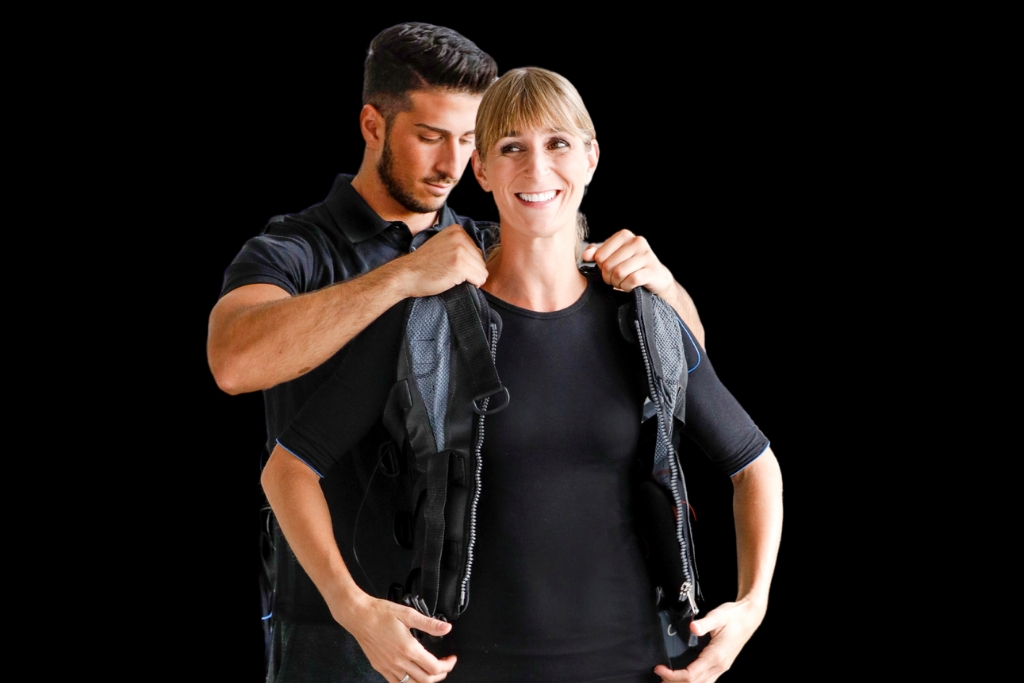When it comes to EMS training, your outfit is more than just a fashion choice—it directly impacts your workout. EMS suits work by using electrical impulses to stimulate your muscles. These impulses need to make direct contact with your skin through the electrodes inside the EMS suit. If you’re wearing clothes made of the wrong material, or if they’re too loose or thick, the electrodes won’t function properly, leading to a weaker or less effective session.
In other words, you won’t get the full benefit of electro-muscle stimulation training if your clothing is getting in the way. Your EMS trainer or fitness trainer for EMS suit sessions will likely guide you on what to wear, but it’s helpful to understand why the right gear matters. Choosing the right clothing helps the EMS suit fit better, improves comfort, and ensures you’re maximizing the value of each session, especially if you’re doing personal training at home.
What Is the Ideal EMS Training Outfit?
When getting ready for an EMS session, wearing the right outfit is key to both comfort and effectiveness. Your clothes help transfer the electrical signals from the suit to your muscles, so they should allow direct contact without interference. The best personal trainer for Electrical Muscle Stimulation will often recommend a specific base layer and gear that works well with the EMS suit. Below are the four essential components of the ideal EMS workout outfit and how each one plays a unique role in your training experience.
1. Base Layer: EMS Undergarments or Cotton Clothing
The first layer you wear during EMS training should be snug-fitting cotton garments. This includes a thin cotton T-shirt and shorts that allow the electrodes to touch your skin directly. Cotton is recommended because it’s moisture-absorbent and helps conduct electricity better than synthetic fabrics. Most EMS studios provide their own training undergarments, but if you’re doing personal EMS training at home, you can purchase your own EMS base layer. Make sure the clothes fit well—not too tight, but definitely not loose. The better the fit, the better the contact with the suit.
2. The EMS Suit
After putting on your base layer, your EMS trainer will help you into the EMS suit, which contains all the necessary electrodes. The suit needs to be properly adjusted to your body shape to ensure even and effective muscle stimulation. A good EMS suit should feel snug like a wetsuit, with built-in wires or pads aligned to your major muscle groups. For personal training at home, make sure your suit is designed for your fitness goals and provides adjustable straps or fasteners. A poorly fitted suit can cause uneven stimulation, discomfort, or reduced effectiveness during the session.
3. Footwear: Keep It Minimal
Many EMS workouts are done barefoot or in grip socks. This helps you stay grounded and maintain proper form during exercises. If shoes are required by your EMS personal trainer or facility, opt for lightweight, flat-soled training shoes. Avoid thick or cushioned sneakers, as they can reduce your stability and disconnect you from floor-based movements. Minimal footwear also improves posture and alignment, which is crucial when doing exercises under electrical stimulation. Whether you’re training at home or in a studio, minimal footwear adds comfort and safety to your workout.
4. Accessories: Less Is More
During electromuscle stimulation training, it’s best to avoid all unnecessary accessories. Jewelry, metal items, or even fitness trackers can interfere with the electrical signals and potentially cause discomfort or risk of skin irritation. If you have long hair, tie it back neatly so it doesn’t get in the way of the suit or electrodes. Keep things simple and functional. The goal is to reduce anything that could block the signal or distract you during training. Trust your EMS trainer—they’ll help make sure you’re wearing only what’s needed.
What to Avoid Wearing
Not every workout outfit is suitable for EMS training. Since the goal is to allow electric impulses to reach your muscles efficiently, wearing the wrong materials or clothing styles can block stimulation or cause discomfort. To help you prepare better, here are some items to avoid when getting dressed for EMS training.
- Loose or Baggy Clothes: Loose clothing creates gaps between your skin and the EMS suit, weakening the contact between electrodes and muscles. This can reduce the effectiveness of the stimulation. Always go for tight-fitting cotton clothing that hugs the body well.
- Thick or Synthetic Fabrics: Materials like polyester, nylon, or spandex don’t absorb moisture properly and can block electrical currents. They also trap heat, which may lead to discomfort during your EMS session.
- Compression Wear: While compression clothing is great for many workouts, it’s often too thick for EMS training. The extra layers can interfere with the suit’s ability to send signals to your muscles.
- Shoes with Thick Soles: Shoes with high or padded soles reduce your connection to the floor and make balance harder during exercises. Flat or minimalist shoes work best, or skip shoes altogether when allowed.
- Wearing Jewelry or Electronics: Remove all metal items like rings, necklaces, or watches before starting your EMS workout. They can interfere with the electrical flow and may cause slight shocks or irritation.
What to Wear for Personal EMS Training at Home
Doing personal EMS training at home has become a convenient option for many people, especially those with busy schedules or a preference for privacy. But even if you’re not in a gym, what you wear still matters just as much. When working with a personal EMS trainer, ask them for recommendations on what to wear during your sessions. If you’re using your own equipment, choose a tight-fitting, moisture-friendly cotton base layer—just like you would in a studio setting.
Make sure your EMS suit fits correctly and is properly adjusted before each session. Also, avoid distractions like loud accessories, thick shoes, or synthetic materials. One of the biggest advantages of personal EMS training at home is having full control over your setup. That includes choosing the right clothing that makes your session safe, comfortable, and effective. Wearing the right outfit ensures your muscles get the full benefit of electro-muscle stimulation training without compromise.
Post-Workout Clothing Tips
After completing an EMS training session, it’s important to change into dry, clean clothing as soon as possible. EMS suits and base layers often hold moisture from sweat or damp electrodes. Staying in wet clothes can be uncomfortable and even increase your risk of skin irritation. Pack a clean outfit for after your workout to help your body cool down and recover properly. Here’s what to include:
- A dry cotton shirt – breathable and soft on the skin
- Comfortable shorts or sweatpants – for easy movement
- Flip-flops or recovery shoes – give your feet a break
- A towel – to dry off if needed
- Water bottle – to stay hydrated after training
Changing quickly keeps you feeling fresh and helps prevent any lingering sweat-related discomfort.
Final Thoughts
EMS training offers a fast, efficient way to build strength, improve muscle tone, and stay fit, especially when guided by the best personal trainer for EMS. But to get the full benefit of this unique workout, wearing the right outfit is essential. Whether you’re training with an EMS personal trainer or doing personal EMS training at home, choose snug-fitting cotton clothing, avoid thick or synthetic materials, and keep accessories to a minimum. Your clothing should support your body and help the EMS suit deliver clean, effective stimulation to your muscles. When you pair smart workout gear with expert guidance from a fitness trainer for EMS suit sessions, you set yourself up for better results, less discomfort, and greater confidence in your fitness journey.

